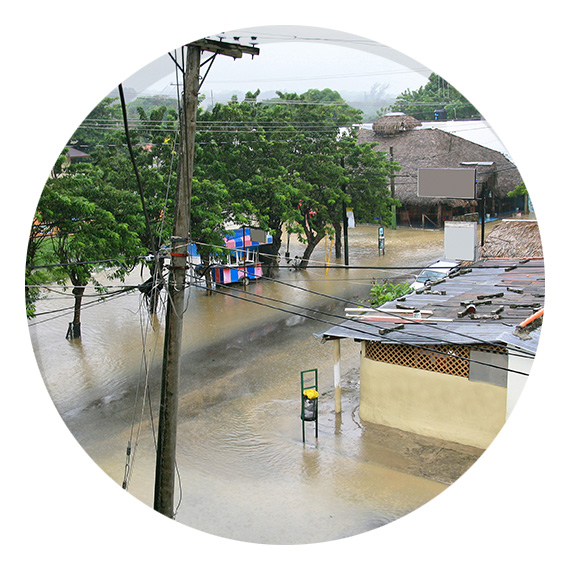A flood in Malawi is different to a flood in Copenhagen

In January 2015, it rained so much in Malawi that the Shire River rose to its highest level in 30 years. The rainfall caused huge floods in which over a hundred people died. Over a million people were indirectly affected by the floods, and a cholera epidemic broke out.
The economic loss resulting from the floods rose to around $335 million. The impact on Malawi's gross national product and purchasing power was relatively small because the country is one of the poorest in the world. In Malawi, the human suffering caused by the floods was indeed much greater than the floods' economic impact.
"The poor became even poorer, and people were driven into poverty", explains Karoliina Pilli-Sihvola from the Finnish Meteorological Institute when describing the situation in Malawi. Ms Pilli-Sihvola's work involves researching extreme weather phenomena and climate change from a social and economic perspective, and she has written a report on the effects of extreme weather in different societies in different parts of the world. Seven of the case studies involved related to torrential rain and three related to snowstorms.
"The structure of society, quality of institutions, and national economic conditions all play a significant part in determining the outcomes of extreme natural phenomena and how the society recovers from the destruction caused", Ms Pilli-Sihvola says.
More developed countries tend to recover from catastrophes quicker than less-developed economies, but in developed countries the emphasis is on the economic consequences. One of the report's case studies related to the torrential rain in Copenhagen in 2011, when over 135mm of rain fell in the city centre within the space of a few hours. What resulted was Europe's "most expensive" weather phenomenon of that year: around €1 billion of insurance compensation was paid out.
The centrality of poverty reduction, land use and forests
It is possible to prepare for extreme natural phenomena, and their impacts can be further reduced. The common factor in the cases studied by Karoliina Pilli-Sihvola is that either such preparations were not made or that damages were incurred in spite of them.
"The best way to reduce people's vulnerability to weather conditions in poor countries is to reduce poverty. This would make it possible, for example, to buy insurance for a house or for the harvest, use other protective mechanisms or move away from high-risk areas", Ms Pilli-Sihvola explains.
In Malawi, many poor people are forced to live next to a river. In the United States and Australia as well, houses have been built in recognised flood zones. After the floods in Queensland in 2011, an entire town on the Australian East Coast was moved away from a flood zone.
In terms of preparation, land use planning plays a key role.
"In Finland, flood risks are properly taken into consideration in land use planning and urban planning. Climate change is also considered. For example, in the new district of Jätkäsaari in Helsinki, the land was raised because of the expected rise in sea level", notes Ms Pilli-Sihvola.
Forests are also very important: they provide protection from floods and reduce the impact of landslides and storms. Additionally, the soil is important for retaining water. For example, in Iceland it has been observed that wind speeds decrease when trees are planted in an area.
"Trees regulate the micro climate and improve ecosystems. Also, forests provide other sources of livelihood and nutrition", Ms Pilli-Sihvola adds.
Early warning systems function well in functioning societies
The use of early warning systems is particularly effective for saving human lives. There are examples of places where an initial cyclone has killed thousands of people but the following one causes no deaths at all owing simply to the fact that the early warning system has done its job.
Almost all countries have some kind of Meteorological Institute and weather forecasts can be made even with minimal resources. In Ms Pilli-Sihvola's opinion, the challenges relate in particular to the authorities' role in society, how cooperation between different authorities is organised and how communication with the public is achieved.
"No matter how good an early warning systems is, people's attitudes and beliefs will affect whether they work or not. People don't necessarily believe the official evacuation orders, or they may not have the capacity to act."
In Finland, the effective preparations and functioning processes are the outcome of long-term development work between authorities. Now we have such good systems in use that they are being exported to other countries: The Finnish Meteorological Institute has decades of experience of international cooperation aimed particularly at improving the level of weather and climate services in developing countries.
Climate change affects extreme phenomena
Climate change is expected to impact the strength and frequency of dangerous weather phenomena.
"Extreme phenomena will increase and strengthen, so societies must be increasingly well-prepared for them. We must adapt to climate change, simply trying to reduce it is no longer enough", emphasises Ms Pilli-Sihvola.
For example, climate change can alter the rainy season. In Ms Pilli-Sihvola's opinion, countries should invest in irrigation systems so that when rainfall comes, the water is retained. Attention must also be paid to the choice of crops. Indeed, she sees boosting farming as a ‘big issue' in Africa.
Ms Pilli-Sihvola points out that not even Finland is immune to climate change.
"If the climate changes according to current projections, there could be large effects on agriculture and forestry, and thus also on security of supply. Also, impacts felt elsewhere can have a knock-on effect and cause problems also in Finland."
The article was originally published in Finnish in Atmos magazine: https://atmoslehti.fi/
